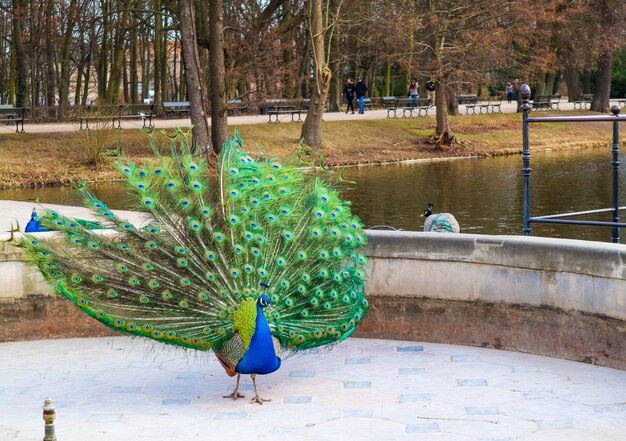Peacocks, with their resplendent plumage and captivating beauty, have fascinated humans for centuries. These birds are known for their striking appearances and extravagant courtship displays. One common belief about peacocks is that they mate for life, forming lifelong bonds with their partners. In this article, we’ll explore the intriguing world of peacock mating behavior to determine whether this popular notion holds true or if it’s just another myth.
Table of Contents
ToggleThe Mating Behavior of Peacocks
Monogamy in the Bird World
Monogamy, or the concept of mating with one partner for life, is relatively rare in the bird kingdom. While some bird species do exhibit monogamous behavior, others are known for their promiscuity. To understand peacock mating habits, it’s essential to consider their broader context within the avian world.
Peacock Courtship Rituals
Peacocks are renowned for their elaborate courtship rituals. When a peacock is ready to attract a mate, it fans its vibrant and colorful tail feathers, creating a mesmerizing display. This courtship dance is meant to impress peahens, the female counterparts, and secure a mate for reproduction.
Peacocks: A Not-So-Monogamous Bird
The Realities of Peacock Relationships
While the courtship rituals of peacocks are enchanting, the idea of lifelong monogamy doesn’t quite fit their nature. In reality, peacocks are not known for forming lifelong partnerships. Their behaviors may lead to short-term pairings, but these connections often don’t last beyond the breeding season.
Seasonal Flings
Peacocks engage in seasonal flings where they may have multiple partners during the breeding season. This behavior is not uncommon in the bird world, where reproductive success often depends on mating with multiple partners to ensure genetic diversity.
Why Do Some Believe Peacocks Mate for Life?
Myth and Reality
The myth of peacocks mating for life may have originated from their striking courtship displays, which can be mistaken for devotion. However, these displays are primarily about attracting mates for the breeding season, not about forming lifelong bonds.
The Concept of Mate for Life
The idea of monogamy in peacocks may also be linked to the human desire to see virtue and commitment in the animal kingdom. Ascribing human-like characteristics to animals can make their behavior more relatable and endearing.
Factors Contributing to the Misconception
Stunning Plumage
The peacock’s stunning plumage, with its iridescent blues and greens, adds to the misconception that they are faithful and loyal partners. People often associate beauty with virtue, assuming that such a magnificent bird must be virtuous in its relationships.
Social Behavior
Peacocks often congregate in groups and display social behaviors that might be interpreted as signs of monogamy. However, these social interactions are primarily a part of their natural behavior and do not necessarily indicate lifelong partnerships.
The Importance of Peacock Pair Bonds
The Role of Partnerships
While peacocks may not mate for life, the bonds they form during the breeding season are essential for successful reproduction. These pair bonds ensure the safety and well-being of their offspring.
Reproduction and Family Life
Peacock pairs work together to build nests, incubate eggs, and raise their chicks. These cooperative efforts are vital for the survival of the peacock’s young.
The Life of a Peacock Couple
Raising Chicks Together
Peacock couples share the responsibilities of parenting. Both partners contribute to caring for their chicks, protecting them from predators, and teaching them valuable survival skills.
Challenges and Struggles
Like any relationship, peacock partnerships have their challenges. They may face competition from other males, and conflicts can arise during the breeding season. These challenges can test the strength of their bonds.
The Peacock’s Search for the Perfect Mate
Challenges of Finding the Right Partner
Peacocks invest time and effort in finding the right partner. They engage in competitive displays to attract peahens and establish their dominance.
Maintaining Attractiveness
Maintaining their stunning plumage and attractiveness is crucial for peacocks, as it increases their chances of finding a suitable mate.
The Conclusion of Peacock Mating Habits
In conclusion, peacocks are fascinating birds with captivating courtship rituals and beautiful plumage. However, the belief that they mate for life is a misconception. While they do form pair bonds during the breeding season and cooperate in parenting, these bonds are not lifelong. Understanding the nuances of peacock mating behavior helps us appreciate these birds’ unique nature.
Frequently Asked Questions
-
Do peacocks really mate for life?
No, peacocks do not mate for life. While they form pair bonds during the breeding season, these connections are not lifelong.
-
Are peacocks known for their fidelity?
Peacocks are not known for fidelity in the sense of lifelong monogamy. They may have multiple partners during the breeding season.
-
How do peacocks choose their partners?
Peacocks choose their partners based on courtship displays and competitive behavior to attract peahens.
-
What is the significance of peacock courtship rituals?
Peacock courtship rituals are essential for attracting mates and ensuring reproductive success.
-
Can peacocks change their partners over time?
Yes, peacocks may change their partners from one breeding season to the next, indicating that their pair bonds are not lifelong.





